Bathing Your Dog
Bathing your dog doesn’t have to be stressful or messy. With the right tools and techniques, it can even become a bonding experience for you and your furry friend. Whether you’re a new dog owner or a seasoned pet parent, this guide will walk you through every step of the bathing process to ensure your dog’s skin and coat stay healthy and clean.
Why Bathing Your Dog Is Important
Bathing is more than just about keeping your dog looking and smelling good. It plays a vital role in maintaining their overall health:
- Promotes Skin and Coat Health: Regular baths remove dirt, allergens, and dead hair, reducing the risk of skin infections.
- Prevents Odor: A clean dog is a fresh-smelling dog, making your home more pleasant.
- Supports Bonding: Bath time can strengthen your bond, provided it’s a calm and positive experience.
Expert Insight:
Overbathing can strip natural oils from your dog’s coat, leading to dry skin. Stick to a schedule that suits your dog’s lifestyle,” explains Dr. Esther Knoetze (BSc)(BVSc)
“For instance, outdoor dogs that love rolling in the mud might need more frequent baths compared to indoor pets.”

How Often Should You Bathe Your Dog?
The frequency of baths depends on several factors, including your dog’s breed, coat type, lifestyle, and even their individual skin condition. Here’s a general guideline:
- Short-haired Breeds: Breeds like Weimaraners and Beagles typically require bathing every 4-6 weeks.
- Oily-coated Breeds: Dogs with naturally oily coats, such as Basset Hounds, may need a bath as often as once a week to manage their coat’s specific needs.
- Double-coated Breeds: Breeds with thick double coats, like Alaskan Malamutes and Golden Retrievers, require less frequent baths (every 6-8 weeks) to preserve their natural oils. However, regular brushing is essential to keep their coats healthy.
- Active Dogs: Dogs that spend a lot of time outdoors or engage in messy activities may need more frequent baths to remove mud and debris.
- Water-repellent Coats: Dogs with water-repellent coats, like Labrador Retrievers, should be bathed sparingly to avoid disrupting the coat’s natural oil balance.
It’s important to remember that overbathing can dry out your dog’s skin. As a rule of thumb, bathe as infrequently as possible while still keeping your dog clean and comfortable.
Bathing frequency varies; some breeds can go months without a bath, while others may require it weekly,” notes Dr. Esther Knoetze. “However, always observe your dog’s skin condition and consult a professional if unsure.”

Preparing for a Stress-Free Bath
Preparation is key to making bath time enjoyable for both you and your dog. Here’s what you need:
What You Need for Bath Time
- Dog Shampoo: Choose one suited to your dog’s coat and skin type.
- Brush: Use before and after the bath to remove loose hair and tangles.
- Non-slip Mat: Prevents slipping in the tub.
- Towels: At least two for drying.
- Treats: To reward your dog and keep them calm.
Choosing the Right Shampoo
Not all shampoos are created equal. Look for products:
- Specifically formulated for dogs.
- Free from artificial fragrances and dyes.
- With natural ingredients like oatmeal or aloe vera for sensitive skin.
Using shampoos with natural ingredients can reduce the risk of skin irritation,” recommends Dr. Esther Knoetze. “Avoid products with harsh chemicals like sulfates or parabens.”

Step-by-Step Guide to Bathing Your Dog
Follow these steps for a smooth and stress-free bath:
Step 1: Brush Your Dog Before the Bath
Brushing removes loose fur and prevents tangles from worsening during the bath.
Step 2: Wet Your Dog and Use Lukewarm Water
Test the water temperature on your wrist to ensure it’s not too hot or too cold. Wet your dog thoroughly, starting at the neck and working your way down to ensure even saturation. If your dog has long hair, wet the coat in the direction it grows to help minimize tangles.
Step 3: Shampoo Application and Lathering
Apply a dog-safe shampoo and gently work it into a lather, starting at the rear and moving toward the head. For short-haired dogs, a rubber washing brush can help distribute the shampoo evenly and loosen dirt. Be sure to clean all areas, including the belly, under the tail, legs, paws, neck, and around the ears. Save the head for last to reduce the chance of shampoo getting into sensitive areas.
Using small, circular motions while applying shampoo can help soothe your dog and ensure a thorough clean,” suggests Dr. Knoetze.
Step 4: Rinse Thoroughly
Using lukewarm water, rinse your dog starting from the head and working backward. This ensures all shampoo is removed without leaving residue, which could irritate your dog’s skin. Patience is key here—rinse until the water runs clear.
Rinse until the water runs clear to prevent shampoo residue, which can irritate the skin,” advises Dr. Knoetze. “I’ve treated many cases of skin irritation caused by improper rinsing.”
Step 5: Thorough Drying
After rinsing, prepare for the inevitable shake-off! Use towels to dry your dog as much as possible, focusing on the paws, belly, and undercoat if applicable. For dogs with thick or long coats, a dog-safe dryer on a low heat setting can help speed up the drying process. Be sure to keep the dryer at least a foot away from your dog’s skin to prevent burns.
Let your dog relax in a warm, sunny room to ensure they are fully dry, especially in colder months.
Drying thoroughly is critical for preventing hotspots and ensuring your dog is comfortable post-bath,” says Dr. Knoetze.

Post-Bath Care for Your Dog
Proper care doesn’t end when the bath is over. Here’s what to do next:
- Brush Again: Prevents tangles and removes any loose hair.
- Check for Skin Issues: Look for redness, dryness, or unusual spots.
- Condition if Necessary: For dogs with dry coats, use a leave-in conditioner.
A post-bath grooming session is the perfect time to look for hidden ticks or skin abnormalities,” says Dr. Knoetze. “Early detection of issues can save your dog from long-term discomfort.”
Seasonal Grooming Needs
Just as the weather changes, so do your dog’s grooming requirements. Here’s how to adapt:
- Winter: Reduce bathing frequency as cold air can dry out your dog’s skin. Use moisturizing shampoos and ensure thorough drying to prevent chills.
- Summer: Increase baths if your dog is active outdoors. Look for shampoos with natural cooling ingredients like aloe vera.
- Spring and Fall: These shedding seasons might require additional brushing to manage loose fur and reduce the need for frequent baths.
Always prioritize your dog’s comfort during baths in extreme weather conditions,” emphasizes Dr. Knoetze. “For instance, warm towels after a winter bath can make a huge difference.”

Common Mistakes to Avoid When Bathing Your Dog
Even well-meaning pet owners can make errors during bath time. Here are the most common mistakes and how to avoid them:
- Using Human Shampoo: While it may be convenient, human shampoo is not formulated for a dog’s skin. It disrupts their natural pH balance, leading to dryness and irritation. Always use a shampoo specifically designed for dogs.
- Overbathing: Bathing too frequently can strip your dog’s coat of its natural oils, leaving the skin dry and flaky. Stick to a schedule that matches your dog’s breed and lifestyle.
- Skipping the Rinse: Any leftover shampoo residue can cause itching or irritation. Take your time to rinse thoroughly, ensuring the water runs clear before finishing.
- Neglecting Sensitive Areas: Areas like the eyes, ears, and face require extra care. Use a damp washcloth instead of direct shampoo to clean these spots.
- Using the Wrong Water Temperature: Too hot or too cold water can make your dog uncomfortable. Always test the water to ensure it’s lukewarm.
- Improper Drying: Leaving your dog damp can lead to hotspots or fungal infections. Dry them thoroughly with towels or a low-heat dryer.
Common mistakes like overbathing or using human shampoos can lead to significant skin problems. Prevention is simple with the right products and techniques tailored to your dog’s needs.”
For more tips on keeping your dog safe and healthy, check out our guides on creating an emergency plan, the 11 warning signs that you should take your dog to the vet, why regular checkups are essential, and the reasons why your dog’s tongue might hang out.

Special Grooming Tips for Different Breeds
Different dog breeds come with unique grooming needs. Tailoring your approach ensures your pet stays comfortable and their coat remains healthy:
- Long-Haired Breeds: Breeds like Afghan Hounds and Shih Tzus benefit from regular brushing and detangling sprays to prevent matting. Pay special attention to areas prone to knots, such as behind the ears and under the legs. After bathing, use a leave-in conditioner to maintain coat shine and softness.
- Short-Haired Breeds: Breeds like Boxers and Dalmatians are low-maintenance but still require proper care. A rubber grooming brush during baths can help remove dead hair and improve circulation. Use a quick-dry towel to speed up the drying process.
- Double-Coated Breeds: Dogs like Siberian Huskies and Border Collies need extra brushing during shedding seasons to manage loose fur. Use a slicker brush post-bath to detangle and remove the undercoat effectively.
- Oily-Coated Breeds: Breeds like Basset Hounds have naturally oily coats that may require weekly baths to control odor. Use a gentle degreasing shampoo formulated specifically for dogs with oily skin.
- Dogs with Skin Conditions: Dogs suffering from allergies, dry skin, or infections should be bathed with vet-recommended medicated shampoos. Always follow your veterinarian’s advice and ensure you rinse thoroughly to avoid irritation.
Understanding your dog’s unique coat needs is key to keeping them healthy and comfortable,” advises Dr. Knoetze. “Grooming isn’t just about appearances; it’s a vital part of their overall well-being.”
Discover helpful tips before bringing a new pet home and ensuring dogs and cats can coexist peacefully.“
FAQs About Bathing Your Dog
Can you bathe a dog with human shampoo?
+No, human shampoo disrupts your dog’s pH balance and can irritate their skin. Dr. Esther Knoetze, BSc, BVSc, explains: “Dogs have more alkaline skin than humans, making human shampoo too harsh for them. Always use a dog-specific shampoo to maintain their skin’s natural barrier.”
What if my dog hates water?
+We understand that bath time can be stressful for some pets. Use treats, toys, and a gradual approach to create a positive experience.
- Start by introducing water in small amounts.
- Reward your dog with treats for calm behavior.
- Keep sessions short and comforting.
How can I reduce shedding during baths?
+Shedding can be controlled with proper pre- and post-bath grooming:
- Before the bath: Brush thoroughly to remove loose hair.
- After the bath: Use a slicker brush or de-shedding tool while the coat is damp.
What is the best way to dry a dog after a bath?
+Use absorbent towels to remove excess water and a dog-safe dryer on a low heat setting. Dr. Knoetze advises: “Ensure your dog is completely dry to prevent skin irritations like hotspots.”
How often should I bathe my puppy?
+Puppies have sensitive skin and should only be bathed every 3–4 weeks unless dirty. Overbathing can strip essential oils, leading to dryness. Dr. Knoetze suggests: “Keep baths infrequent and use gentle puppy-specific shampoos.”
Can I bathe my dog if they have fleas?
+Yes, but use a flea shampoo specifically designed for dogs. Always follow up with a vet-recommended flea treatment plan. Dr. Knoetze emphasizes: “Bathing alone isn’t enough to eliminate fleas entirely. Pair it with preventative treatments for the best results.”
Should I trim my dog’s nails after a bath?
+Yes! Nail trimming is easier after a bath because the water softens the nails. Dr. Knoetze explains: “Softened nails are less likely to crack, making trimming safer and more comfortable.”
Can I use conditioner on my dog?
+Yes, but only use conditioners made for dogs. Dr. Knoetze explains: “Dog-safe conditioners keep coats hydrated and shiny without disrupting skin health.”
Conclusion
Bathing your dog doesn’t have to be complicated. With proper preparation, the right tools, and a little patience, you can keep your dog clean, happy, and healthy. Try these tips during your next bath time and share your experience in the comments!
Share Your Dog Bathing Tips!
We’d love to hear about your experiences and tips for making bath time stress-free for your furry friends! Share your favorite grooming products, tricks, and success stories in the comments section below.
Don’t forget to connect with us on social media for expert advice, grooming guides, and updates about keeping your dog happy and healthy. Need help? Contact Tailwaggors for trusted resources and support.
🐾 Love dogs as much as we do? 🐶
Share this guide with fellow dog owners and help them discover everything they need to keep their dogs safe, happy, and healthy. Forward it now! 📬












